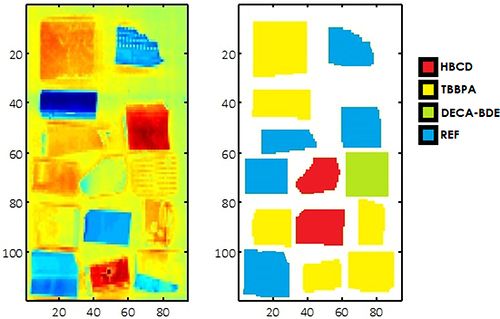Spectral Imaging Improves Plastics Recycling
In a paper published in the Journal of Spectral Imaging, José Amigo at the University of Copenhagen, Denmark, and colleagues describe a method that uses near-infrared (NIR) hyperspectral imaging and chemometrics to sort plastics that contain different types of plastic and plastics that contain different additions of flame retardants.
To reduce the quantity of plastics that are dumped into the environment, efficient recycling is essential. But many plastics cannot be economically sorted for recycling, and sorting plastics that contain flame retardants is particularly important. Plastics that contain flame retardants to increase their resistance to ignition, reduce flames spreading, minimize smoke formation, and prevent the plastic from dripping can vary considerably in the amount and type of flame retardant that is added to them, because of the need to tailor the plastic to its particular application and to meet safety standards. Before recycling can occur, plastics require sorting by type and by flame retardant added. Without sorting, recycling cannot take place.
In a paper published in the Journal of Spectral Imaging, José Amigo at the University of Copenhagen, Denmark, and colleagues describe a method that uses near-infrared (NIR) hyperspectral imaging and chemometrics to sort plastics that contain different types of plastic and plastics that contain different additions of flame retardants (1).
Near infrared hyperspectral imaging of samples of plastics and their classification as a function of type of flame-retardant: 1,2,5,6,9,10-hexabromo-cyclododecane, HBCD (red samples); 3,5-tetrabromobisphenol A, TBBPA (yellow samples); Pentabromophenyl ether, Deca-BDE (green samples); and reference, REF (blue samples).

By using an imaging technique, the approach developed by Amigo can be used during the plastics sorting on a conveyor belt in a recycling plant.
The method discussed in the paper uses a decision tree chemometrics approach combined with spectral data obtained from NIR hyperspectral imaging and is able to distinguish between different plastics and flame retardants within them with 100% accuracy.
Although sorting of recycling plastics has been studied for many years, Amigo wanted to take that process a step further and make it possible to separate plastics by flame retardant. They also tested the technique to be practical. “Moreover, the proposed methodology was tested with real samples that can be found in current recycling lines,” Amigo said.
Reference
D. Caballero, M. Bevilacqua, and J.M. Amigo, J. Spectral Imaging8, a1 (2019). https://doi.org/10.1255/jsi.2019.a1
How Satellite-Based Spectroscopy is Transforming Inland Water Quality Monitoring
Published: April 29th 2025 | Updated: April 29th 2025New research highlights how remote satellite sensing technologies are changing the way scientists monitor inland water quality, offering powerful tools for tracking pollutants, analyzing ecological health, and supporting environmental policies across the globe.
Chinese Researchers Develop Dual-Channel Probe for Biothiol Detection
April 28th 2025Researchers at Qiqihar Medical University have developed a dual-channel fluorescent probe, PYL-NBD, that enables highly sensitive, rapid, and selective detection of biothiols in food, pharmaceuticals, and living organisms.
The fNIRS Glossary Project: A Community-Sourced Glossary of Key Terms
April 28th 2025Established to develop a community-sourced glossary covering key functional near-infrared spectroscopy (fNIRS) terms, including those related to the continuous-wave (CW), frequency-domain (FD), and time-domain (TD) NIRS techniques, the fNIRS Glossary Project features over 300 terms categorized into six key domains: analysis, experimental design, hardware, neuroscience, mathematics, and physics. It also includes abbreviations, symbols, synonyms, references, alternative definitions, and figures where relevant.